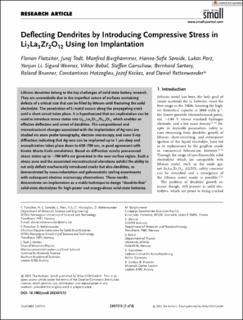| dc.contributor.author | Flatscher, Florian | |
| dc.contributor.author | Todt, Juraj | |
| dc.contributor.author | Burghammer, Manfred | |
| dc.contributor.author | Søreide, Hanne-Sofie Marie Scisly | |
| dc.contributor.author | Porz, Lukas | |
| dc.contributor.author | Li, Yanjun | |
| dc.contributor.author | Wenner, Sigurd | |
| dc.contributor.author | Bobal, Viktor | |
| dc.contributor.author | Ganschow, Steffen | |
| dc.contributor.author | Sartory, Bernhard | |
| dc.contributor.author | Brunner, Roland | |
| dc.contributor.author | Hatzoglou, Constantinos | |
| dc.contributor.author | Keckes, Jozef | |
| dc.contributor.author | Rettenwander, Daniel | |
| dc.date.accessioned | 2024-02-20T11:40:51Z | |
| dc.date.available | 2024-02-20T11:40:51Z | |
| dc.date.created | 2023-11-22T08:46:30Z | |
| dc.date.issued | 2023 | |
| dc.identifier.citation | Small. 2023, 2307515. | en_US |
| dc.identifier.issn | 1613-6810 | |
| dc.identifier.uri | https://hdl.handle.net/11250/3118641 | |
| dc.description.abstract | Lithium dendrites belong to the key challenges of solid-state battery research. They are unavoidable due to the imperfect nature of surfaces containing defects of a critical size that can be filled by lithium until fracturing the solid electrolyte. The penetration of Li metal occurs along the propagating crack until a short circuit takes place. It is hypothesized that ion implantation can be used to introduce stress states into Li6.4La3Zr1.4Ta0.6O12 which enables an effective deflection and arrest of dendrites. The compositional and microstructural changes associated with the implantation of Ag-ions are studied via atom probe tomography, electron microscopy, and nano X-ray diffraction indicating that Ag-ions can be implanted up to 1 µm deep and amorphization takes place down to 650–700 nm, in good agreement with kinetic Monte Carlo simulations. Based on diffraction results pronounced stress states up to −700 MPa are generated in the near-surface region. Such a stress zone and the associated microstructural alterations exhibit the ability to not only deflect mechanically introduced cracks but also dendrites, as demonstrated by nano-indentation and galvanostatic cycling experiments with subsequent electron microscopy observations. These results demonstrate ion implantation as a viable technique to design “dendrite-free” solid-state electrolytes for high-power and energy-dense solid-state batteries. | en_US |
| dc.language.iso | eng | en_US |
| dc.publisher | Wiley | en_US |
| dc.rights | Navngivelse 4.0 Internasjonal | * |
| dc.rights.uri | http://creativecommons.org/licenses/by/4.0/deed.no | * |
| dc.title | Deflecting Dendrites by Introducing Compressive Stress in Li7La3Zr2O12 Using Ion Implantation | en_US |
| dc.title.alternative | Deflecting Dendrites by Introducing Compressive Stress in Li7La3Zr2O12 Using Ion Implantation | en_US |
| dc.type | Peer reviewed | en_US |
| dc.type | Journal article | en_US |
| dc.description.version | publishedVersion | en_US |
| dc.rights.holder | © 2023 The Authors. Small published by Wiley-VCH GmbH. | en_US |
| dc.source.pagenumber | 8 | en_US |
| dc.source.journal | Small | en_US |
| dc.identifier.doi | 10.1002/smll.202307515 | |
| dc.identifier.cristin | 2199993 | |
| dc.relation.project | Norges forskningsråd: 309584 | en_US |
| dc.relation.project | Norges forskningsråd: 269842 | en_US |
| dc.relation.project | Norges forskningsråd: 295864 | en_US |
| dc.relation.project | NORTEM: 197405 | en_US |
| dc.source.articlenumber | 2307515 | en_US |
| cristin.ispublished | true | |
| cristin.fulltext | original | |
| cristin.qualitycode | 1 | |

